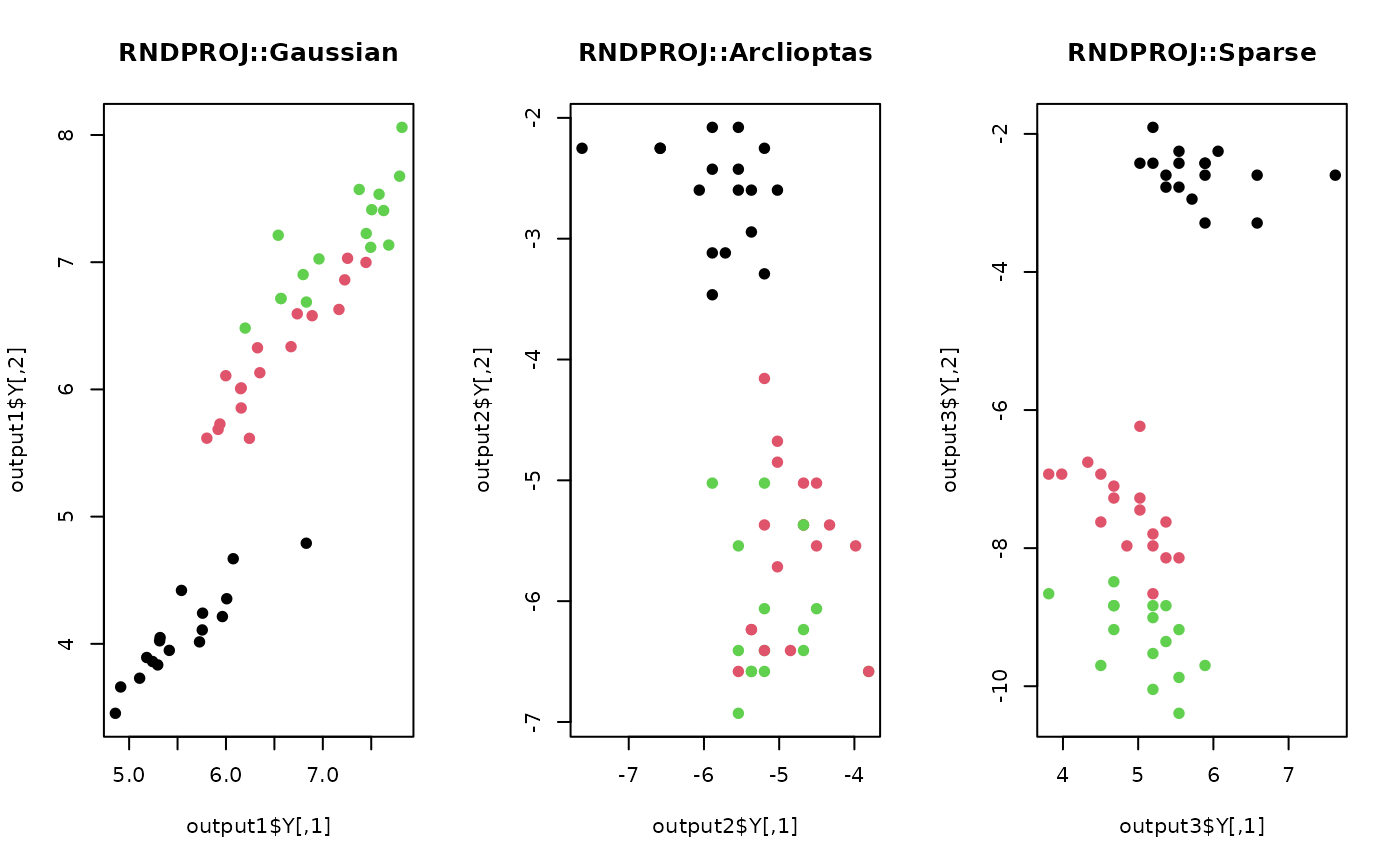do.rndproj is a linear dimensionality reduction method based on
random projection technique, featured by the celebrated Johnson–Lindenstrauss lemma.
Arguments
- X
an \((n\times p)\) matrix or data frame whose rows are observations and columns represent independent variables.
- ndim
an integer-valued target dimension.
- preprocess
an additional option for preprocessing the data. Default is "null". See also
aux.preprocessfor more details.- type
a type of random projection, one of "gaussian","achlioptas" or "sparse".
- s
a tuning parameter for determining values in projection matrix. While default is to use \(max(log \sqrt{p},3)\), it is required for \(s \ge 3\).
Value
a named list containing
- Y
an \((n\times ndim)\) matrix whose rows are embedded observations.
- projection
a \((p\times ndim)\) whose columns are basis for projection.
- epsilon
an estimated error \(\epsilon\) in accordance with JL lemma.
- trfinfo
a list containing information for out-of-sample prediction.
Details
The Johnson-Lindenstrauss(JL) lemma states that given \(0 < \epsilon < 1\), for a set \(X\) of \(m\) points in \(R^N\) and a number \(n > 8log(m)/\epsilon^2\), there is a linear map \(f:R^N\) to R^n such that $$(1-\epsilon)|u-v|^2 \le |f(u)-f(v)|^2 \le (1+\epsilon)|u-v|^2$$ for all \(u,v\) in \(X\).
Three types of random projections are supported for an (p-by-ndim) projection matrix \(R\).
Conventional approach is to use normalized Gaussian random vectors sampled from unit sphere \(S^{p-1}\).
Achlioptas suggested to employ a sparse approach using samples from \(\sqrt{3}(1,0,-1)\) with probability \((1/6,4/6,1/6)\).
Li et al proposed to sample from \(\sqrt{s}(1,0,-1)\) with probability \((1/2s,1-1/s,1/2s)\) for \(s\ge 3\) to incorporate sparsity while attaining speedup with little loss in accuracy. While the original suggsetion from the authors is to use \(\sqrt{p}\) or \(p/log(p)\) for \(s\), any user-supported \(s \ge 3\) is allowed.
References
Johnson WB, Lindenstrauss J (1984). “Extensions of Lipschitz Mappings into a Hilbert Space.” In Beals R, Beck A, Bellow A, Hajian A (eds.), Contemporary Mathematics, volume 26, 189--206. American Mathematical Society, Providence, Rhode Island. ISBN 978-0-8218-5030-5 978-0-8218-7611-4.
Achlioptas D (2003). “Database-Friendly Random Projections: Johnson-Lindenstrauss with Binary Coins.” Journal of Computer and System Sciences, 66(4), 671--687.
Li P, Hastie TJ, Church KW (2006). “Very Sparse Random Projections.” In Proceedings of the 12th ACM SIGKDD International Conference on Knowledge Discovery and Data Mining, KDD '06, 287--296.
Examples
## use iris data
data(iris)
set.seed(100)
subid = sample(1:150, 50)
X = as.matrix(iris[subid,1:4])
label = as.factor(iris[subid,5])
## 1. Gaussian projection
output1 <- do.rndproj(X,ndim=2)
## 2. Achlioptas projection
output2 <- do.rndproj(X,ndim=2,type="achlioptas")
## 3. Sparse projection
output3 <- do.rndproj(X,type="sparse")
## Visualize three different projections
opar <- par(no.readonly=TRUE)
par(mfrow=c(1,3))
plot(output1$Y, pch=19, col=label, main="RNDPROJ::Gaussian")
plot(output2$Y, pch=19, col=label, main="RNDPROJ::Arclioptas")
plot(output3$Y, pch=19, col=label, main="RNDPROJ::Sparse")
 par(opar)
par(opar)